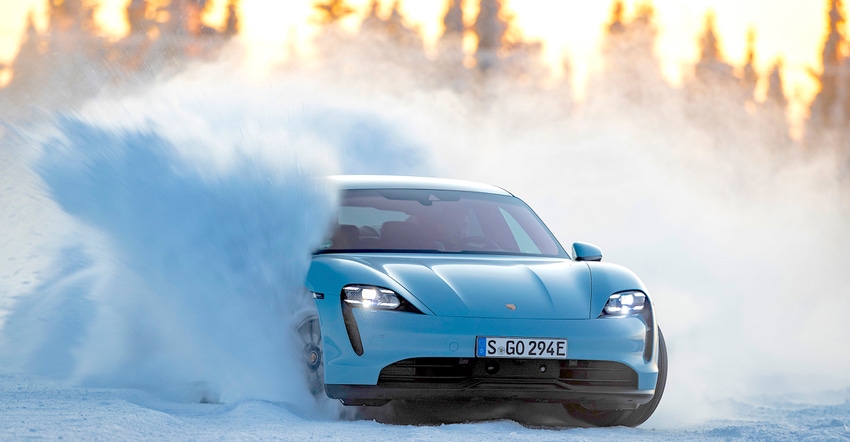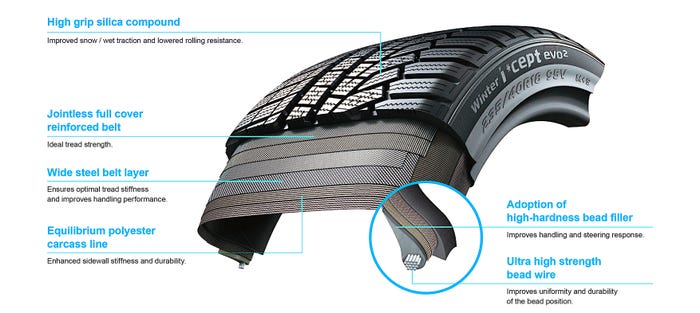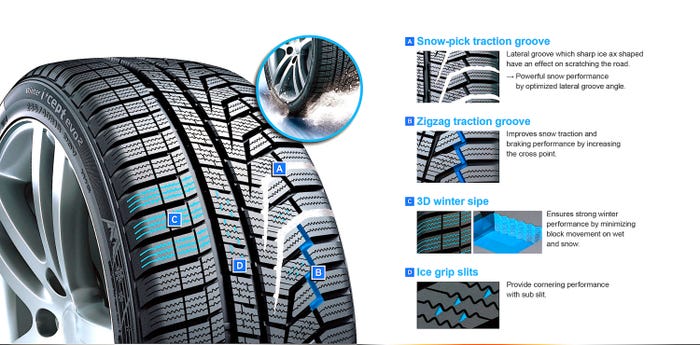SUVs have the reputation for winter-driving prowess, but slick-road security all depends on the tires.
February 7, 2022

J.J. Park
When debating whether winter tires are worth the investment and effort, consider this: you wouldn’t wear basketball shoes in a blizzard. Just as someone in boots would outlast even the most athletic person in sneakers, a two-wheel-drive economy car equipped with proper snow tires will often perform miles better than a lifted truck with beefy mud-terrain tires or a rally-inspired hatchback with a fully locking differential.
And it all comes down to the technology.
While often a nondescript component of the vehicle, a car’s tires are essentially its footwear, the only four contact points with the road while driving. As a result, it is essential to give the vehicle the best grip possible. Winter tires are carefully engineered with performance in cold conditions in mind.
AWD and 4WD are a good start.
Having all-wheel or four-wheel drive enables each tire to translate engine power to the ground. Logically, having two additional tires rotating under power will assist in forward or backward movement, especially from a standstill. However, if those four driven wheels struggle to find grip on a snowy or icy surface, your solution isn’t more power, it’s more traction. A simple equation to reinforce this is “4 x 0 = 0” – meaning it doesn’t matter how many wheels are turning if available traction is zero.
Suppose the tire only has an all-season compound and tread pattern for traction. That limits the vehicle’s ability to apply and translate forces – including those necessary for acceleration, deceleration, and cornering ability – to the ground by the available grip of that tire. For example, a vehicle could have a top-of-the-line braking assembly with carbon-ceramic discs and 8-piston calipers fitted. Those brakes, with all their stopping power, will only be able to slow down the car as much as the tire’s grip allows in that driving environment before ABS systems (if equipped) intervene.
A dedicated winter tire is an example of how material science can provide a dedicated product for a specific function. In this case, it’s a specific mix of polymers designed to produce a rubber compound that performs best when temperatures are below freezing. This, combined with a unique tread pattern that digs into snow and ice rather than sliding across it, delivers a tire that expands a vehicle’s grip capacity and increases the car’s ability to handle applied forces – such as a sudden slam on the brakes – without overwhelming traction or compromising control.
Consider the glass transition point.
Unique to polymers, including the rubber used in tires, the glass transition point refers to the operating temperature range of a tire’s compound. It is the temperature at which the tire gets harder due to the molecules within starting to move less freely. A helpful example to consider is what happens when you leave a plastic painter’s bucket outside during the winter. It will crack or break more easily in the cold weather, than when left outside in warmer seasons.
The same goes for winter formulated compounds versus summer mixtures. It all boils down to mixing a specific ratio of involved materials to achieve the ideal blend for the intended environment and use. Winter tires are formulated to remain pliable and softer compared to other segments, meaning better traction and performance when the temperatures dip below freezing.
It should be noted this phenomenon works both ways; when the temperature climbs in the summer months, an all-season or summer tire is stickier, while a winter tire risks getting washed out, heavy, and also wear out considerably quicker.

Purpose in the performance pattern.
Let’s revisit the shoe analogy. While tread patterns of an Ultra High Performance (UHP) summer or all-season tire run parallel, a winter tire will have horizontal and zig-zag patterns. These patterns are the footprint of the snow boot, which are often deeper and more angular than the tread on a basketball shoe. The tire’s zig-zag, horizontal patterns allow for extra digging force and a biting edge to increase traction in snow and ice. That means a winter tire will offer increased control over all of the vehicle’s performance categories. Having a better grasp of how the vehicle operates in these conditions not only makes for a better driver but perhaps, more importantly, a safer driver.

Saved by the sipes.
The real secret weapon of snow tires comes in the form of small etches at the top of each tread block. These small grooves or “sipes” allow additional flexion of the tread block to grip ice and pack in snow when driving. The same concept applies here as rolling a snowman, for example. Snow is sticky onto itself. By packing material into the tires, the vehicle is essentially mimicking that process and enabling the tires to perform better. It offers a better grip and, in turn, better control of the vehicle.
From the grip technology to the performance pattern, and the compounds to the sipes, each of these technical elements works together to ensure that winter tires offer the most traction and control on slippery, icy roads and in the coldest conditions.
J.J. Park is a vice president at Hankook Tire America, where the company's technical service team is one of his areas of responsibility.
You May Also Like



